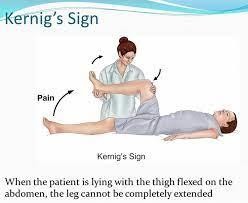Which of the following describes the correct procedure for testing for Kernig's sign?
Rotate the neck to one side while observing the eyes moving to the opposite side.
Passively elevate the leg with extended knee while observing for pain, resistance, or flexion.
Stroke the lateral aspect of the sole of the patient's foot and observe for dorsiflexion of the big toe.
Passively flex the patient's neck forward and observe for hip and knee flexion.
The Correct Answer is B
Choice A rationale: Rotating the neck to one side while observing the eyes moving to the opposite side is a procedure for testing for oculocephalic reflex or doll's eye
phenomenon, which indicates brainstem function.
Choice B rationale: This is the correct answer. Kernig's sign is a clinical sign that indicates meningitis, which is an inflammation of the membranes that cover the brain and spinal cord. To test for Kernig's sign, the nurse should flex the patient's hip to 90 degrees and then attempt to extend the knee. A positive Kernig's sign is when the patient
experiences pain in the lower back or hamstring, resists knee extension, or involuntarily flexes the opposite leg.
Choice C rationale: Stroking the lateral aspect of the sole of the patient's foot and observing for dorsiflexion of the big toe is a procedure for testing for Babinski's sign, which indicates upper motor neuron lesion or damage.
Choice D rationale: Passively flexing the patient's neck forward and observing for hip and knee flexion is a procedure for testing for Brudzinski's sign, which also indicates meningitis.
 |
Nursing Test Bank
Naxlex Comprehensive Predictor Exams
Related Questions
Correct Answer is C
Explanation
Choice A rationale: This statement is correct; it's important to include the final voided urine in the collection.
Choice B rationale: Proper storage at a cool temperature helps maintain the integrity of the collected urine.
Choice C rationale: Avoiding protein intake during the collection can significantly alter the results of the creatinine clearance test. Eating a regular diet is important to maintain accurate test results.
Choice D rationale: Discarding the first void and starting the collection afterward is a common practice in 24-hour urine collections to ensure a complete sample.
Correct Answer is D
Explanation
Choice A rationale: The combination treats gonorrhea and chlamydia but not trichomonas.
Choice B rationale: While important, this combination aims to treat multiple potential infections, not solely prevent reinfection.
Choice C rationale: The dual therapy doesn’t cover syphilis; it's specifically targeted for gonorrhea and chlamydia.
Choice D rationale: Azithromycin covers both gonorrhea and chlamydia, so the combination ensures coverage for both possible infections.
Whether you are a student looking to ace your exams or a practicing nurse seeking to enhance your expertise , our nursing education contents will empower you with the confidence and competence to make a difference in the lives of patients and become a respected leader in the healthcare field.
Visit Naxlex, invest in your future and unlock endless possibilities with our unparalleled nursing education contents today
Report Wrong Answer on the Current Question
Do you disagree with the answer? If yes, what is your expected answer? Explain.
Kindly be descriptive with the issue you are facing.
